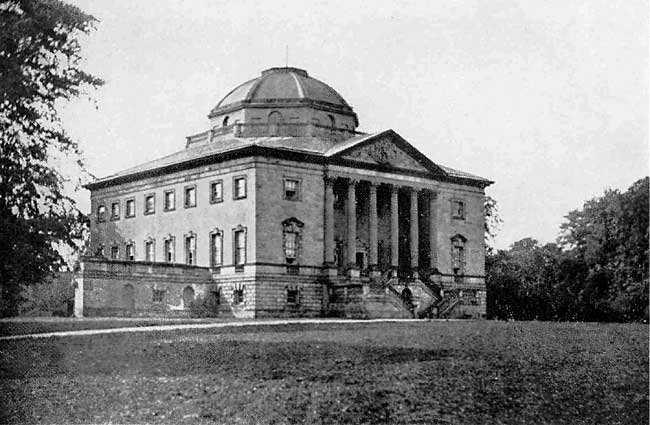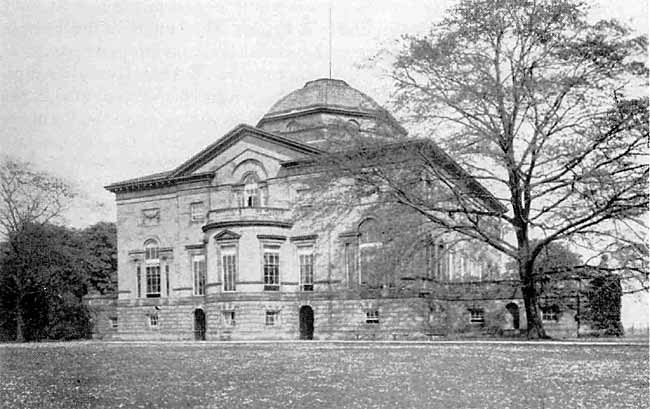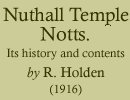Nuthall Temple
 |
| Plate I. Nuthall Temple, East Front. |
Nuthall Temple, so called from its shape, was built by Sir Charles Sedley, second baronet, of Southfleet, who was elected M.P. for Nottingham in 1741, 1747, and 1774. His father, the first baronet, inherited the Nuthall estate through his marriage with Elizabeth Firth, granddaughter and co-heiress, with her sister Mrs. Chaworth of Annesley Park, of Mr. Richard Slater.
The names of the families who owned the Nuthall estate, previous to Richard Slater, are Ayscough, de Cokefield, and St. Patrick. The builder of the Temple had no son, and on his death, which took place in 1778, the property passed to his daughter, Elizabeth Rebecca Anne, who married the Hon. Henry Vernon, second son of the first Lord Vernon of Sudbury, Derbyshire. He took the name of Sedley, but eventually on his succeeding to the title and estate of the Vernons, the name of Sedley was dropped. His eldest son, the Hon. George Charles Vernon, in accordance with his parents' marriage settlement, inherited Nuthall on his father succeeding to Sudbury. In 1819 he sold the estate to his friend, Robert Holden, of Darley Abbey, Derbyshire, who obtained an Act of Parliament to enable him to sell his settled estates in Derbyshire and Yorkshire, in order that he might purchase Nuthall.
The foundations of the Temple were laid in 1754, and it was inhabited in 1757. There had been a Hall at Nuthall for many centuries. King John, before his accession, was at Nuthall when he granted to the Priory of Lenton the woods and heath about Bestwood, and his other woods in Nottinghamshire and Derbyshire. The old Hall is believed to have stood somewhere near where the conservatory in the flower garden is now. Nothing is known of its style of architecture or size. The Temple was copied from the original Rotunda of Palladio - the Villa Capra, near Vicenza, in northern Italy, from designs by Mr. T. Wright. Three other houses on the same model were built about the same time:- Mereworth Castle (which belongs to Lord Falmouth), Footscray Place (both in Kent), and Chiswick House, on the Thames. The plan of these houses consists of a central hall, on the first floor, with a dome. The chimneys converge to the top of the dome, so none are visible. The Temple is a square building with two low wings, one on the south side, and the other on the north. It is approached on the east side by a double flight of steps, which lead to a portico supported by lofty pillars. The portico is under the roof of the house. The Villa Capra has a portico on each of its four sides: so has Mereworth Castle, where each portico has its own roof which is supported by pillars, not so lofty as those at the Temple, on three sides. On the pediment over the portico is a graceful stone figure of Diana, with her bow and hound. The portico leads to a vestibule, where may be noticed an uncommon umbrella stand and a hat stand - both Sheraton - and four William IV. period chairs. On the walls are a large picture with figures of Cupid and fruit, portrait of a gendeman in armour, large portrait of a gentleman, large picture - mountain landscape with figures on horseback, and a pair of signed engravings by T.J. Barber - Indian Mutiny and Crimean scenes. Glass doors lead from the vestibule to the hall. These doors, which replaced wooden ones, were set there by J. Holden (1848-1913).
 |
| Plate II. Nuthall Temple, West Front. |
The hall is octagonal, with a domed roof. Eight doors lead from it to various apartments and the front and back stairs. These doors are on four of the sides, there being alcoves, each containing two. The height of the dome is fifty-nine feet, and the width thirty-six feet. Sixteen feet from the floor is a gallery, seven feet wide, supported by eight pillars. The walls and ceiling of the hall are richly decorated with plaster work, wrought on the spot by Italian workmen. The festoons on the walls above the gallery are of four subjects: music, sport, science, and warfare, with replicas of each. The medallions in the centre of each festoon represent eight of Aesop's fables, namely:- the fox and the leopard, the wolf and the lamb, the bear and the bees, the wolf and the crane, the fox and the lion, the fox and the grapes, the stag at the pool, and the fox and the crane. The goat's head issuing from a crown, over each door in the gallery was the crest of the Sedley family. Under the gallery, in front of the four alcoves, are symbolic representations of earth, air, fire, and water - a lion, an eagle, a phoenix, and a dolphin. The white marble carved mantel-piece, attributed to Adam, is worth attention. It is one of the few original mantel-pieces now left in the house. The others are in the following rooms:- the small sitting room, near the side entrance to the dining room, the two bedrooms on the second floor near the back stairs, and the portico room. The white marble mantelpiece in the music room is partly original, but has been lowered. The balustrade round the gallery is of wrought iron, and is believed to be the work of Bakewell, of Derby.
